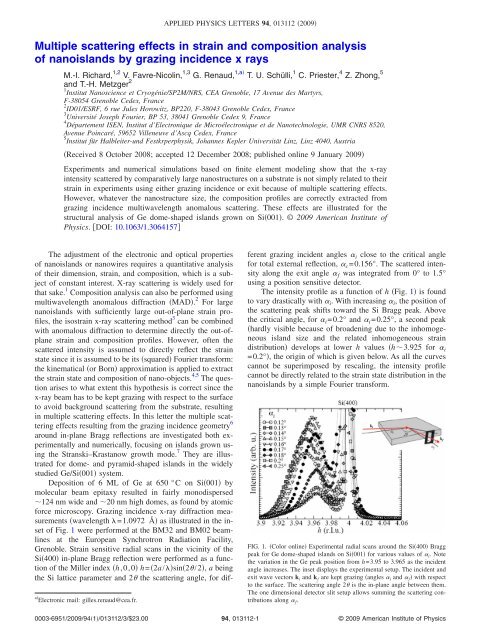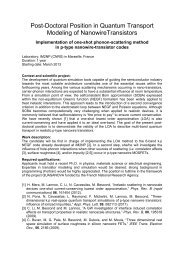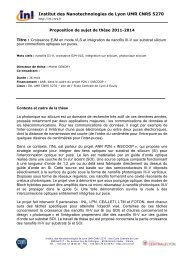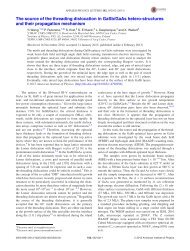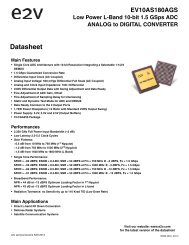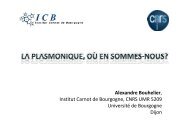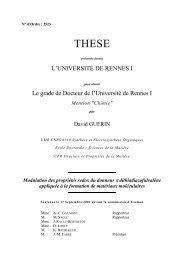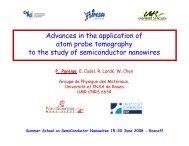Multiple scattering effects in strain and composition analysis ... - IEMN
Multiple scattering effects in strain and composition analysis ... - IEMN
Multiple scattering effects in strain and composition analysis ... - IEMN
Create successful ePaper yourself
Turn your PDF publications into a flip-book with our unique Google optimized e-Paper software.
APPLIED PHYSICS LETTERS 94, 013112 2009<br />
<strong>Multiple</strong> <strong>scatter<strong>in</strong>g</strong> <strong>effects</strong> <strong>in</strong> stra<strong>in</strong> <strong>and</strong> <strong>composition</strong> <strong>analysis</strong><br />
of nanoisl<strong>and</strong>s by graz<strong>in</strong>g <strong>in</strong>cidence x rays<br />
M.-I. Richard, 1,2 V. Favre-Nicol<strong>in</strong>, 1,3 G. Renaud, 1,a T. U. Schülli, 1 C. Priester, 4 Z. Zhong, 5<br />
<strong>and</strong> T.-H. Metzger 2<br />
1 Institut Nanoscience et Cryogénie/SP2M/NRS, CEA Grenoble, 17 Avenue des Martyrs,<br />
F-38054 Grenoble Cedex, France<br />
2 ID01/ESRF, 6 rue Jules Horowitz, BP220, F-38043 Grenoble Cedex, France<br />
3 Université Joseph Fourier, BP 53, 38041 Grenoble Cedex 9, France<br />
4 Département ISEN, Institut d’Electronique de Microélectronique et de Nanotechnologie, UMR CNRS 8520,<br />
Avenue Po<strong>in</strong>caré, 59652 Villeneuve d’Ascq Cedex, France<br />
5 Institut für Halbleiter-und Festkrperphysik, Johannes Kepler Universität L<strong>in</strong>z, L<strong>in</strong>z 4040, Austria<br />
Received 8 October 2008; accepted 12 December 2008; published onl<strong>in</strong>e 9 January 2009<br />
Experiments <strong>and</strong> numerical simulations based on f<strong>in</strong>ite element model<strong>in</strong>g show that the x-ray<br />
<strong>in</strong>tensity scattered by comparatively large nanostructures on a substrate is not simply related to their<br />
stra<strong>in</strong> <strong>in</strong> experiments us<strong>in</strong>g either graz<strong>in</strong>g <strong>in</strong>cidence or exit because of multiple <strong>scatter<strong>in</strong>g</strong> <strong>effects</strong>.<br />
However, whatever the nanostructure size, the <strong>composition</strong> profiles are correctly extracted from<br />
graz<strong>in</strong>g <strong>in</strong>cidence multiwavelength anomalous <strong>scatter<strong>in</strong>g</strong>. These <strong>effects</strong> are illustrated for the<br />
structural <strong>analysis</strong> of Ge dome-shaped isl<strong>and</strong>s grown on Si001. ©2009 American Institute of<br />
Physics. DOI: 10.1063/1.3064157<br />
a Electronic mail: gilles.renaud@cea.fr.<br />
The adjustment of the electronic <strong>and</strong> optical properties<br />
of nanoisl<strong>and</strong>s or nanowires requires a quantitative <strong>analysis</strong><br />
of their dimension, stra<strong>in</strong>, <strong>and</strong> <strong>composition</strong>, which is a subject<br />
of constant <strong>in</strong>terest. X-ray <strong>scatter<strong>in</strong>g</strong> is widely used for<br />
that sake. 1 Composition <strong>analysis</strong> can also be performed us<strong>in</strong>g<br />
multiwavelength anomalous diffraction MAD. 2 For large<br />
nanoisl<strong>and</strong>s with sufficiently large out-of-plane stra<strong>in</strong> profiles,<br />
the isostra<strong>in</strong> x-ray <strong>scatter<strong>in</strong>g</strong> method 3 can be comb<strong>in</strong>ed<br />
with anomalous diffraction to determ<strong>in</strong>e directly the out-ofplane<br />
stra<strong>in</strong> <strong>and</strong> <strong>composition</strong> profiles. However, often the<br />
scattered <strong>in</strong>tensity is assumed to directly reflect the stra<strong>in</strong><br />
state s<strong>in</strong>ce it is assumed to be its squared Fourier transform:<br />
the k<strong>in</strong>ematical or Born approximation is applied to extract<br />
the stra<strong>in</strong> state <strong>and</strong> <strong>composition</strong> of nano-objects. 4,5 The question<br />
arises to what extent this hypothesis is correct s<strong>in</strong>ce the<br />
x-ray beam has to be kept graz<strong>in</strong>g with respect to the surface<br />
to avoid background <strong>scatter<strong>in</strong>g</strong> from the substrate, result<strong>in</strong>g<br />
<strong>in</strong> multiple <strong>scatter<strong>in</strong>g</strong> <strong>effects</strong>. In this letter the multiple <strong>scatter<strong>in</strong>g</strong><br />
<strong>effects</strong> result<strong>in</strong>g from the graz<strong>in</strong>g <strong>in</strong>cidence geometry 6<br />
around <strong>in</strong>-plane Bragg reflections are <strong>in</strong>vestigated both experimentally<br />
<strong>and</strong> numerically, focus<strong>in</strong>g on isl<strong>and</strong>s grown us<strong>in</strong>g<br />
the Stranski–Krastanow growth mode. 7 They are illustrated<br />
for dome- <strong>and</strong> pyramid-shaped isl<strong>and</strong>s <strong>in</strong> the widely<br />
studied Ge/Si001 system.<br />
Deposition of 6 ML of Ge at 650 °C on Si001 by<br />
molecular beam epitaxy resulted <strong>in</strong> fairly monodispersed<br />
124 nm wide <strong>and</strong> 20 nm high domes, as found by atomic<br />
force microscopy. Graz<strong>in</strong>g <strong>in</strong>cidence x-ray diffraction measurements<br />
wavelength =1.0972 Å as illustrated <strong>in</strong> the <strong>in</strong>set<br />
of Fig. 1 were performed at the BM32 <strong>and</strong> BM02 beaml<strong>in</strong>es<br />
at the European Synchrotron Radiation Facility,<br />
Grenoble. Stra<strong>in</strong> sensitive radial scans <strong>in</strong> the vic<strong>in</strong>ity of the<br />
Si400 <strong>in</strong>-plane Bragg reflection were performed as a function<br />
of the Miller <strong>in</strong>dex h,0,0 h=2a/s<strong>in</strong>2/2, a be<strong>in</strong>g<br />
the Si lattice parameter <strong>and</strong> 2 the <strong>scatter<strong>in</strong>g</strong> angle, for different<br />
graz<strong>in</strong>g <strong>in</strong>cident angles i close to the critical angle<br />
for total external reflection, c =0.156°. The scattered <strong>in</strong>tensity<br />
along the exit angle f was <strong>in</strong>tegrated from 0° to 1.5°<br />
us<strong>in</strong>g a position sensitive detector.<br />
The <strong>in</strong>tensity profile as a function of h Fig. 1 is found<br />
to vary drastically with i . With <strong>in</strong>creas<strong>in</strong>g i , the position of<br />
the <strong>scatter<strong>in</strong>g</strong> peak shifts toward the Si Bragg peak. Above<br />
the critical angle, for i =0.2° <strong>and</strong> i =0.25°, a second peak<br />
hardly visible because of broaden<strong>in</strong>g due to the <strong>in</strong>homogeneous<br />
isl<strong>and</strong> size <strong>and</strong> the related <strong>in</strong>homogeneous stra<strong>in</strong><br />
distribution develops at lower h values h3.925 for i<br />
=0.2°, the orig<strong>in</strong> of which is given below. As all the curves<br />
cannot be superimposed by rescal<strong>in</strong>g, the <strong>in</strong>tensity profile<br />
cannot be directly related to the stra<strong>in</strong> state distribution <strong>in</strong> the<br />
nanoisl<strong>and</strong>s by a simple Fourier transform.<br />
FIG. 1. Color onl<strong>in</strong>e Experimental radial scans around the Si400 Bragg<br />
peak for Ge dome-shaped isl<strong>and</strong>s on Si001 for various values of i . Note<br />
the variation <strong>in</strong> the Ge peak position from h=3.95 to 3.965 as the <strong>in</strong>cident<br />
angle <strong>in</strong>creases. The <strong>in</strong>set displays the experimental setup. The <strong>in</strong>cident <strong>and</strong><br />
exit wave vectors k i <strong>and</strong> k f are kept graz<strong>in</strong>g angles i <strong>and</strong> f with respect<br />
to the surface. The <strong>scatter<strong>in</strong>g</strong> angle 2 is the <strong>in</strong>-plane angle between them.<br />
The one dimensional detector slit setup allows summ<strong>in</strong>g the <strong>scatter<strong>in</strong>g</strong> contributions<br />
along f .<br />
0003-6951/2009/941/013112/3/$23.00<br />
94, 013112-1<br />
© 2009 American Institute of Physics
013112-2 Richard et al. Appl. Phys. Lett. 94, 013112 2009<br />
FIG. 2. Color onl<strong>in</strong>e a Simulated radial scan <strong>in</strong>tensities around the<br />
Si400 reflection for Ge isl<strong>and</strong>s on Si001 whose stra<strong>in</strong> has been calculated<br />
by FDM: a 124 nm wide <strong>and</strong> 20 nm high dome. The <strong>in</strong>tensity is <strong>in</strong>tegrated<br />
between f 0° <strong>and</strong> f 1.5°. The total DWBA <strong>in</strong>tensity is reported for<br />
different <strong>in</strong>cident angles <strong>and</strong> compared to the BA first path <strong>in</strong>tensity. The<br />
substrate <strong>scatter<strong>in</strong>g</strong> has been omitted. b Evolution of t i ,z 2 <strong>in</strong>aGe<br />
dome on Si001 as a function of height z <strong>and</strong> i / c for =1.097 Å. As the<br />
<strong>in</strong>tensity scattered by each z-layer above the surface is proportional to<br />
t i ,z 2 , an x-ray <strong>scatter<strong>in</strong>g</strong> experiment will predom<strong>in</strong>antly reflect the<br />
stra<strong>in</strong> state of a given height depend<strong>in</strong>g on i rather than the full isl<strong>and</strong><br />
stra<strong>in</strong> state distribution. c Same as a but for a 70 nm wide <strong>and</strong> 7 nm high<br />
pyramid.<br />
To underst<strong>and</strong> this effect, four paths accord<strong>in</strong>g to the<br />
distorted wave Born approximation DWBA have to be<br />
taken <strong>in</strong>to account, 8,9<br />
F DWBA =<br />
f j e ik f −k i ·r j + r i f j e ik f +k i ·r j<br />
jQDs<br />
jQDs<br />
+ r f f j e i−k f −k i ·r j<br />
jQDs<br />
+ r i r f f j e i−k f +k i ·r j,<br />
jQDs<br />
where f j is the atomic <strong>scatter<strong>in</strong>g</strong> factor <strong>and</strong> r j is the position<br />
of an atom j <strong>in</strong> the isl<strong>and</strong>; k i <strong>and</strong> k f are the <strong>in</strong>com<strong>in</strong>g <strong>and</strong> exit<br />
wave vectors <strong>and</strong> r i,f are the reflectivities of the <strong>in</strong>cident<br />
<strong>and</strong> scattered waves. The first term <strong>in</strong> Eq. 1, which we call<br />
first path, corresponds to the k<strong>in</strong>ematical <strong>scatter<strong>in</strong>g</strong> of the<br />
<strong>in</strong>cident wave by the isl<strong>and</strong>s or Born approximation BA.<br />
The three other terms imply s<strong>in</strong>gle or double reflections by<br />
the substrate. 8<br />
To <strong>in</strong>terpret these observations, the stra<strong>in</strong> field <strong>in</strong> a coherent<br />
Ge/Si001 dome-shaped isl<strong>and</strong> with the experimental<br />
width <strong>and</strong> height was calculated with the f<strong>in</strong>ite difference<br />
method FDM, 10 assum<strong>in</strong>g cont<strong>in</strong>uum theory of elasticity.<br />
For simplicity, a pure Ge dome was modeled. The scattered<br />
<strong>in</strong>tensity see Fig. 2a was then calculated us<strong>in</strong>g Eq. 1<br />
around the <strong>in</strong>-plane Si400 reflection for different values<br />
of i around c <strong>and</strong> summed up between f 0° <strong>and</strong> f<br />
1.5° to account for the experimental conditions. The isl<strong>and</strong><br />
form factor given by the BA shows two broad peaks that<br />
arise from two prevalent stra<strong>in</strong> states <strong>in</strong> the dome-shaped<br />
isl<strong>and</strong>: the first peak close to the Si Bragg peak corresponds<br />
to the basis <strong>and</strong> also to the ma<strong>in</strong> part of the isl<strong>and</strong>, which is<br />
surrounded by the 113 <strong>and</strong> 15323 facets, while the second<br />
peak results from the stra<strong>in</strong> state of the top part of the<br />
isl<strong>and</strong>, term<strong>in</strong>ated by 105 facets. For i =0.62 c , only one<br />
1<br />
maximum is present <strong>in</strong> the simulated radial scan. It is positioned<br />
at h=3.944, i.e., displaced compared to the real<br />
maxima h=3.925 <strong>and</strong> 3.954 of the stra<strong>in</strong> state given by the<br />
first path. Above the critical angle, the positions of the <strong>in</strong>tensity<br />
maxima are close to the real positions of the maxima of<br />
the stra<strong>in</strong> state given by the first path.<br />
To discuss these <strong>effects</strong>, the isl<strong>and</strong>s can be decomposed<br />
<strong>in</strong>to layers of different heights z, each hav<strong>in</strong>g its own lattice<br />
parameter az. With this hypothesis, a radial position h corresponds<br />
to the <strong>scatter<strong>in</strong>g</strong> by a given layer at z. We also<br />
suppose case of Ge isl<strong>and</strong>s on Si that the higher z, the<br />
larger the lattice parameter <strong>and</strong> hence the smaller h. With<strong>in</strong><br />
the DWBA <strong>and</strong> as k z i,f = 2/ s<strong>in</strong> i,f , for small <strong>in</strong>cident<br />
<strong>and</strong> exit angles, the amplitude scattered at a given h by the<br />
portion of the isl<strong>and</strong> at height z can be written as 11<br />
F z DWBA i , f = F z BA h, i , f t i ,zt f ,z,<br />
where F z BA is the isl<strong>and</strong> form factor at height z <strong>and</strong> t,z<br />
=1+re −4iz/ is a generalized optical function. t i ,z<br />
varies as a function of i <strong>and</strong> z, as illustrated <strong>in</strong> Fig. 2b.<br />
Hence, the <strong>in</strong>tensity distribution <strong>in</strong> Fig. 2a results from the<br />
product of the isl<strong>and</strong> form factor by the generalized optical<br />
function. Because z is directly correlated with h, the optical<br />
function varies along the radial direction. If the value of i is<br />
below or at the critical angle of the substrate, the optical<br />
function can be very strongly enhanced for certa<strong>in</strong> heights z<br />
<strong>and</strong> thus for the correspond<strong>in</strong>g radial positions h. Low <strong>in</strong>cident<br />
angles maximize the generalized optical function for<br />
high z values <strong>and</strong> thus maximize the scattered <strong>in</strong>tensity at<br />
lower h values. For i =0.62 c , this maximum corresponds<br />
to z20 nm see Fig. 2b, i.e., the <strong>in</strong>tensity scattered by<br />
the isl<strong>and</strong>’s top, where it is the most relaxed, is strongly<br />
enhanced. Above the critical angle, the optical function does<br />
not display strong m<strong>in</strong>ima <strong>and</strong> maxima; the multiple <strong>scatter<strong>in</strong>g</strong><br />
<strong>effects</strong> can be neglected, <strong>and</strong> the k<strong>in</strong>ematical approximation<br />
is recovered. The condition for these DWBA <strong>effects</strong> to<br />
be significant is 11<br />
= rzH2/ahd /dz 1,<br />
where H is the total height of the nanocrystal, z is the<br />
parallel stra<strong>in</strong> of an isostra<strong>in</strong> area at height z, <strong>and</strong> rz is its<br />
radius. Hence, this phenomenon is observed only for large<br />
enough isl<strong>and</strong>s, with large enough vertical stra<strong>in</strong> gradient.<br />
For the simulated Ge dome, 10. For smaller isl<strong>and</strong>s with<br />
smaller stra<strong>in</strong> gradient, these multiple <strong>scatter<strong>in</strong>g</strong> <strong>effects</strong> are<br />
not observed. This was checked <strong>in</strong> the case of a small Ge<br />
pyramid on Si001 see Fig. 2c for which the <strong>in</strong>tensities<br />
simulated for different i values can be superimposed. Indeed,<br />
<strong>in</strong> that case, the DWBA <strong>analysis</strong> for isl<strong>and</strong>s on a substrate<br />
is identical to that of isl<strong>and</strong>s buried below the surface:<br />
the total scattered amplitude see Eq. 2 is proportional to<br />
the form factor amplitude, F BA k f −k i , accord<strong>in</strong>g to<br />
F DWBA i , f = F BA k f − k i t i t f ,<br />
where t i,f is the usual amplitude transmission function as<br />
a function of <strong>in</strong>cident exit angle.<br />
Hav<strong>in</strong>g determ<strong>in</strong>ed for which conditions the DWBA has<br />
to be used <strong>in</strong>stead of the BA, the question arises whether the<br />
st<strong>and</strong>ard MAD <strong>analysis</strong> us<strong>in</strong>g the BA is still valid for large<br />
isl<strong>and</strong>s under graz<strong>in</strong>g <strong>in</strong>cidence. Equation 2 shows that the<br />
<strong>in</strong>tensity scattered by a stripe at height z is simply the BA<br />
<strong>in</strong>tensity multiplied by the <strong>in</strong>cident <strong>and</strong> exit generalized op-<br />
2<br />
3<br />
4
013112-3 Richard et al. Appl. Phys. Lett. 94, 013112 2009<br />
Ge content<br />
1<br />
α<br />
0.8<br />
i<br />
=0.12°<br />
<br />
α i<br />
=0.2°<br />
<br />
<br />
<br />
0.6<br />
<br />
<br />
<br />
<br />
<br />
<br />
<br />
<br />
<br />
<br />
<br />
<br />
<br />
<br />
<br />
<br />
<br />
<br />
0.4<br />
<br />
<br />
<br />
<br />
0.2<br />
<br />
<br />
<br />
<br />
<br />
<br />
0<br />
3.9 3.92 3.94 3.96 3.98<br />
h (r.l.u.)<br />
FIG. 3. Color onl<strong>in</strong>e Ge content as a function of h as extracted us<strong>in</strong>g<br />
graz<strong>in</strong>g <strong>in</strong>cidence MAD with 12 different energies around the Ge K-edge.<br />
The Ge content extracted for two different <strong>in</strong>cident angles rema<strong>in</strong>s consistent<br />
<strong>in</strong> spite of the strong Ih dependence with i .<br />
tical functions, which are energy <strong>in</strong>dependent far from c <strong>in</strong><br />
the case of a buffer conta<strong>in</strong><strong>in</strong>g nonanomalous atoms. Therefore<br />
dur<strong>in</strong>g a MAD experiment the extracted structure factors<br />
are F Ge <strong>and</strong> F Si multiplied by these functions. S<strong>in</strong>ce the Ge<br />
<strong>composition</strong> is extracted by a ratio of these factors accord<strong>in</strong>g<br />
to x Ge = f Si F Ge /f 0 0<br />
Ge F Si + f Si F Ge , where f Ge <strong>and</strong> f Si are the<br />
Ge Thomson atomic form factor <strong>and</strong> the Si atomic form factor,<br />
respectively, the generalized optical functions disappear<br />
from the result, <strong>and</strong> the deduced <strong>composition</strong> is not affected<br />
by multiple <strong>scatter<strong>in</strong>g</strong> <strong>effects</strong>. This result was experimentally<br />
checked by compar<strong>in</strong>g the results of graz<strong>in</strong>g-<strong>in</strong>cidence MAD<br />
<strong>analysis</strong> of the dome sample for different <strong>in</strong>cident angles.<br />
Figure 3 shows the Ge <strong>composition</strong> calculated from the Ge<br />
<strong>and</strong> Si structure factors F Si <strong>and</strong> F Ge , which were extracted<br />
for two <strong>in</strong>cident angles without any structural hypothesis,<br />
<strong>and</strong> ref<strong>in</strong>ed through a least-squares m<strong>in</strong>imization us<strong>in</strong>g<br />
a dedicated program. 12 This program evaluates the uncerta<strong>in</strong>ties<br />
of F Ge <strong>and</strong> F Si <strong>and</strong> hence the error bars on the Ge<br />
<strong>composition</strong>. The partial structure factors are affected by the<br />
generalized optical function as is the total <strong>scatter<strong>in</strong>g</strong> amplitude.<br />
However, only slight variations <strong>in</strong> the Ge <strong>composition</strong><br />
are observed, with overlapp<strong>in</strong>g error bars. Hence, the correct<br />
Ge content is extracted, whatever the conditions of <strong>in</strong>cidence.<br />
A BA treatment of anomalous diffraction can thus be<br />
performed to extract the <strong>composition</strong> of isostra<strong>in</strong> regions of<br />
the isl<strong>and</strong>s. The subcritical regime i c yields smaller<br />
<strong>scatter<strong>in</strong>g</strong> from the substrate <strong>and</strong> is thus preferred.<br />
To conclude, for large isl<strong>and</strong>s, multiple <strong>scatter<strong>in</strong>g</strong> <strong>effects</strong><br />
strongly distort the <strong>in</strong>tensity distribution <strong>in</strong> reciprocal space<br />
<strong>and</strong> need a complete DWBA <strong>analysis</strong> to extract the lattice<br />
parameter distribution. By contrast, the <strong>in</strong>-plane stra<strong>in</strong> <strong>in</strong><br />
small isl<strong>and</strong>s can be <strong>in</strong>vestigated us<strong>in</strong>g a BA treatment.<br />
Hence, <strong>scatter<strong>in</strong>g</strong> from small <strong>and</strong> large isl<strong>and</strong>s can be dist<strong>in</strong>guished<br />
simply by vary<strong>in</strong>g the <strong>in</strong>cident angle around the<br />
critical angle c , check<strong>in</strong>g if the <strong>in</strong>tensities can be superimposed<br />
to each other by rescal<strong>in</strong>g. This may be most useful for<br />
bimodal isl<strong>and</strong> growth e.g., pyramids <strong>and</strong> domes <strong>in</strong> the<br />
Ge/Si case to discrim<strong>in</strong>ate the orig<strong>in</strong> of the measured <strong>in</strong>tensity.<br />
Most importantly, the st<strong>and</strong>ard MAD <strong>analysis</strong> can be<br />
applied to all isl<strong>and</strong>s as long as the x-ray energy is far from<br />
an absorption edge of the substrate <strong>and</strong> the substrate does not<br />
conta<strong>in</strong> any elements violat<strong>in</strong>g this condition.<br />
Z.Z. acknowledges support from the FWF, Vienna. We<br />
acknowledge Hubert Renevier for fruitful discussions.<br />
1 J. Stangl, V. Holý, <strong>and</strong> G. Bauer, Rev. Mod. Phys. 76, 7252004.<br />
2 A. Létoublon, V. Favre-Nicol<strong>in</strong>, H. Renevier, M. G. Proietti, C. Monat, M.<br />
Gendry, O. Marty, <strong>and</strong> C. Priester, Phys. Rev. Lett. 92, 186101 2004.<br />
3 I. Kegel, T.-H. Metzger, A. Lorke, J. Peisl, J. Stangl, G. Bauer, J. M.<br />
Garcia, <strong>and</strong> P. Petroff, Phys. Rev. Lett. 85, 1694 2000.<br />
4 T. U. Schülli, J. Stangl, Z. Zhong, R. T. Lechner, M. Sztucki, T. H.<br />
Metzger, <strong>and</strong> G. Bauer, Phys. Rev. Lett. 90, 066105 2003; T. U. Schülli,<br />
M. Stoffel, J. Stangl, R. T. Lechner, E. W<strong>in</strong>tersberger, M. Sztucki, T. H.<br />
Metzger, O. G. Schmidt, <strong>and</strong> G. Bauer, Phys. Rev. B 71, 035326 2005.<br />
5 A. Malachias, S. Kycia, G. Medeiros-Ribeiro, R. Magalhães-Paniago, T. I.<br />
Kam<strong>in</strong>s, <strong>and</strong> R. Stanley Williams, Phys. Rev. Lett. 91, 176101 2003.<br />
6 M. Schmidbauer, D. Grigoriev, M. Hanke, P. Schafer, T. Wiebach, <strong>and</strong> R.<br />
Kohler, Phys. Rev. B 71, 115324 2005.<br />
7 I. N. Stranski <strong>and</strong> L. Krastanow Sitzungsber. Akad. Wiss. Wien, Math.-<br />
Naturwiss. Kl., Abt. 2B 146, 797 1938.<br />
8 M. Rauscher, R. Paniago, H. Metzger, Z. Kovats, J. Domke, H. D.<br />
Pfannes, J. Schulze, <strong>and</strong> I. Eisele, J. Appl. Phys. 86, 6763 1999.<br />
9 J. Coraux, V. Favre-Nicol<strong>in</strong>, M. G. Proietti, B. Daud<strong>in</strong>, <strong>and</strong> H. Renevier,<br />
Phys. Rev. B 75, 235312 2007.<br />
10 V. Ranjan, G. Allan, C. Priester, <strong>and</strong> C. Delerue, Phys. Rev. B 68, 115305<br />
2003.<br />
11 I. Kegel, T.-H. Metzger, A. Lorke, J. Peisl, J. Stangl, G. Bauer, K. Nordlund,<br />
W. V. Schoenfeld, <strong>and</strong> P. Petroff, Phys. Rev. B 63, 035318 2001.<br />
12 V. Favre-Nicol<strong>in</strong>, <strong>in</strong> preparation.


